Last updated on
Discover the essential tips and tricks to ensure your couch smoothly fits through your door without any hassle.
Moving into a new home or apartment is an exciting experience, but it can also be stressful. One of the biggest challenges that homeowners and renters face is getting their furniture through the door.
It’s not uncommon to fall in love with a couch or sectional only to realize that it won’t fit through your front door! In this article, we’ll discuss some tips and tricks for measuring your furniture and doorways to ensure a smooth move-in process. So, before you make any big purchases, let’s make sure that your couch will fit through your door!
- Measure your couch dimensions and compare them to your doorway
- Assess your doorway, hallways, and stairwells for potential obstacles
- Measure door and hallway openings to determine if your couch will fit
- Consider disassembling your couch or using alternative entry points
- Clear furniture and obstacles in the path of moving your couch
Table of Contents
Measuring Your Couch Dimensions

The first step in ensuring that your couch will fit through your door is to measure its dimensions. Start by measuring the length, width, and height of the couch.
Be sure to include any protruding parts such as armrests or legs in your measurements.
Once you have these measurements, compare them with the dimensions of your doorway. If you’re unsure about how to take accurate measurements or if there are any irregularities in either measurement (such as a curved sofa), it’s best to consult with a professional furniture mover who can help guide you through this process.
Remember that even if the couch itself fits through the doorway, other factors such as angles and corners may still pose challenges during moving day.
Assessing Your Doorway

Start by measuring the width and height of the doorway, as well as any hallways or stairwells leading up to it. Keep in mind that even if your couch fits through the door, you may still need to navigate tight corners or narrow hallways.
If you’re unsure about whether a particular piece of furniture will fit through a specific opening, consider creating a cardboard cutout of its dimensions and testing it out before making any purchases. This can save you time and money down the line by preventing costly returns or damage during move-in day.
Remember that while assessing your doorway is an important first step, there are other factors to consider when moving furniture into a new space.
Measuring Door and Hallway Openings
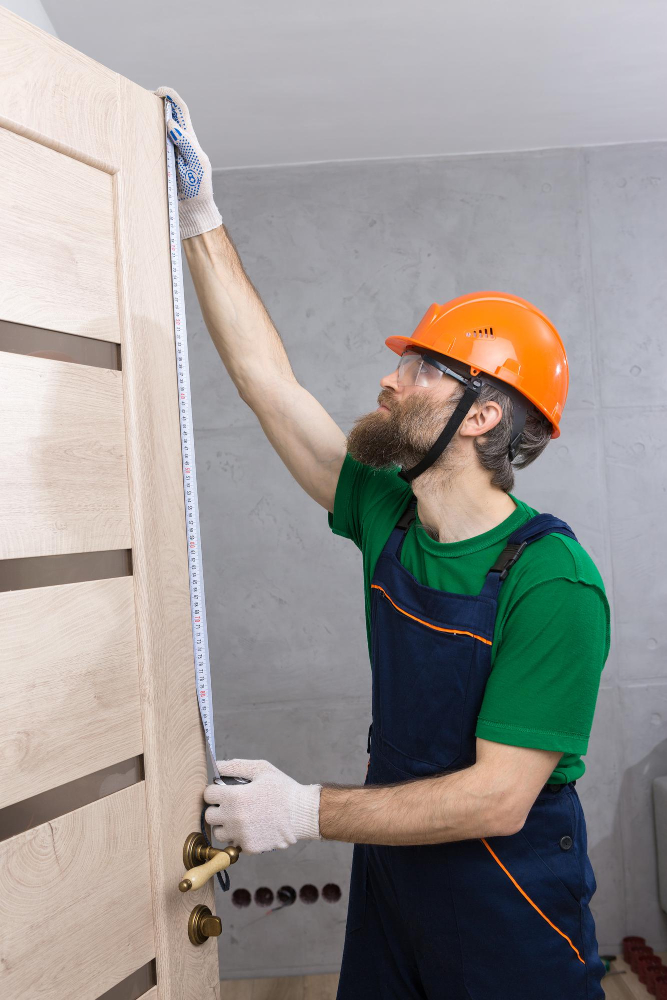
This will help you determine if there are any potential obstacles that could prevent your furniture from fitting through. To do this, grab a measuring tape and measure the height and width of each doorway or hallway opening that the couch needs to pass through.
It’s important to note that not all doorways are created equal. Some may be wider than others, while some may have lower ceilings or narrower hallways leading up to them.
Be sure to take these factors into account when measuring.
If you’re unsure about how wide or tall a particular doorway is, don’t hesitate to ask for help! You can always enlist a friend or family member with experience in moving furniture for assistance.
Comparing Couch and Opening Sizes
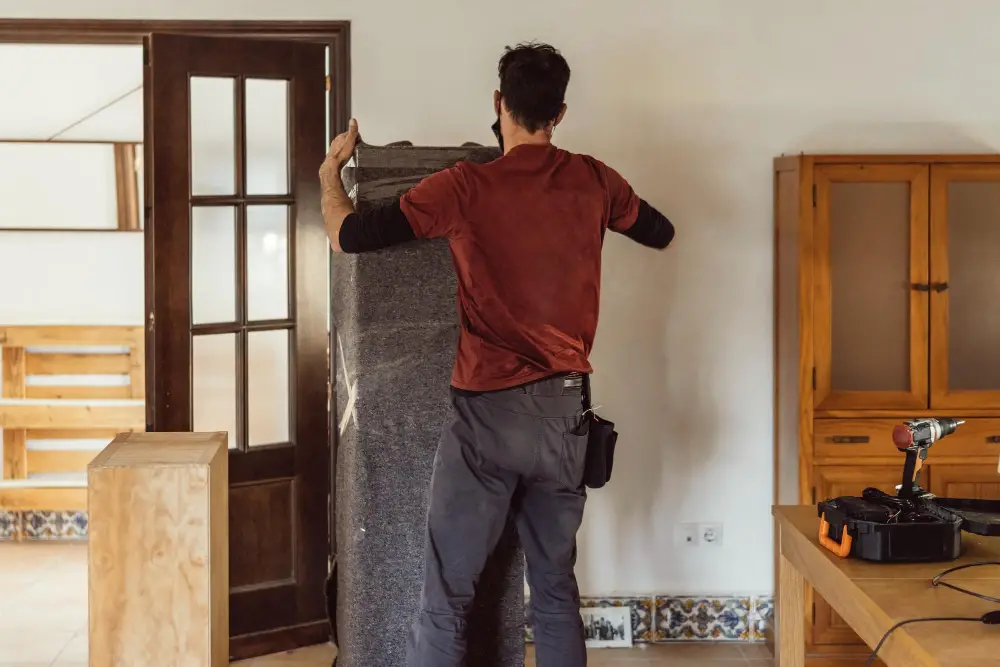
If the measurements are close, you may be able to maneuver the couch through with some effort. However, if there is a significant difference between the size of your couch and opening, then it’s best to consider alternative options.
One option is disassembling your furniture into smaller pieces that can fit through narrow openings. This process involves removing cushions or legs from sofas or sectionals so that they can be more easily transported.
Another option is considering different entry points for moving in large furniture items such as windows or balconies if available. In some cases where all other options fail delivery companies offer specialized equipment like cranes which help lift heavy objects up several floors without damaging them.
Disassembling Your Couch

Before you start taking apart your furniture, make sure that you have a clear understanding of how it was assembled in the first place. Take pictures or videos of each step so that you can easily put everything back together later.
Start by removing any cushions and pillows from the couch. Then, look for screws or bolts holding different parts of the sofa together such as arms and legs.
Use a screwdriver or wrench to remove them carefully.
Be mindful not to damage any part while disassembling; this will ensure easy reassembly once inside your home. Keep all hardware in one place like a ziplock bag so they don’t get lost during transportation.
Removing Cushions and Other Parts

The first thing you can try is removing the cushions from your sofa. This will make it easier to maneuver through tight spaces.
If your couch has detachable legs or arms, consider taking them off as well. You’ll be surprised at how much space this frees up! Just make sure that you keep all of these parts in a safe place so that they don’t get lost during the move.
Once everything has been removed from your couch, measure again before attempting another move-through attempt. If it’s still not fitting properly after removing cushions and other parts then disassembling might be necessary which we will discuss in detail later on in this article.
Sofa Bed Considerations

Sofa beds can be heavier and bulkier than traditional couches, which can make them more difficult to move through doorways and hallways. The mechanism that allows the sofa to convert into a bed may add extra width or height that could cause issues when trying to fit it through your doorway.
Before making any purchases, measure both your doorway and the fully extended length of the sofa bed. Consider disassembling any parts of the frame or removing cushions before attempting to move it through tight spaces.
It’s also important to note that not all sofa beds are created equal in terms of size and weight. Some models may be designed specifically for smaller spaces with narrow doorways while others may require professional movers due their size or complexity.
Angles and Corners

If you have tight spaces or sharp turns in your home, getting a couch through them can seem impossible. However, there are some tricks that you can use to make the process easier.
Firstly, try tilting the couch at an angle so that one end is higher than the other. This will reduce its overall height and width and allow it to fit through narrow openings more easily.
Secondly, consider removing any legs or arms from your sofa if possible as this will also help reduce its size.
Lastly, don’t forget about pivoting! Sometimes all it takes is rotating your couch on an angle while keeping one end stationary until you get around those tricky corners.
Clearing Furniture and Obstacles
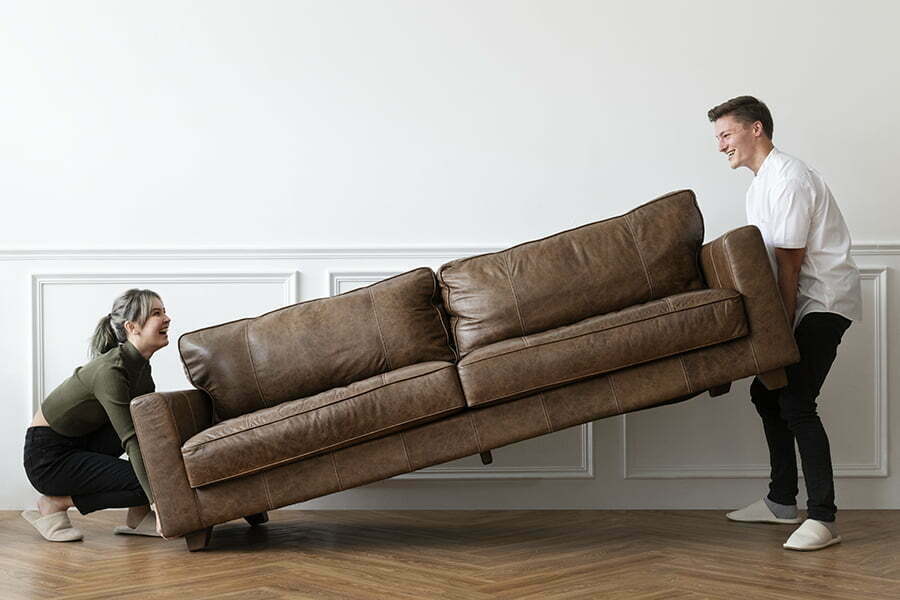
Before you start moving your couch, take a look around the room and identify any potential obstacles that may be in the way. This could include coffee tables, lamps, or other pieces of furniture.
If possible, move these items out of the way to create a clear path for your couch to pass through. If there are larger pieces of furniture that cannot be moved easily, consider covering them with blankets or sheets to protect both them and your sofa during transit.
It’s also important to remove any wall hangings or decorations from nearby walls as they can get knocked off during movement causing damage not only on themselves but also on other items around it.
Removing Door Hardware
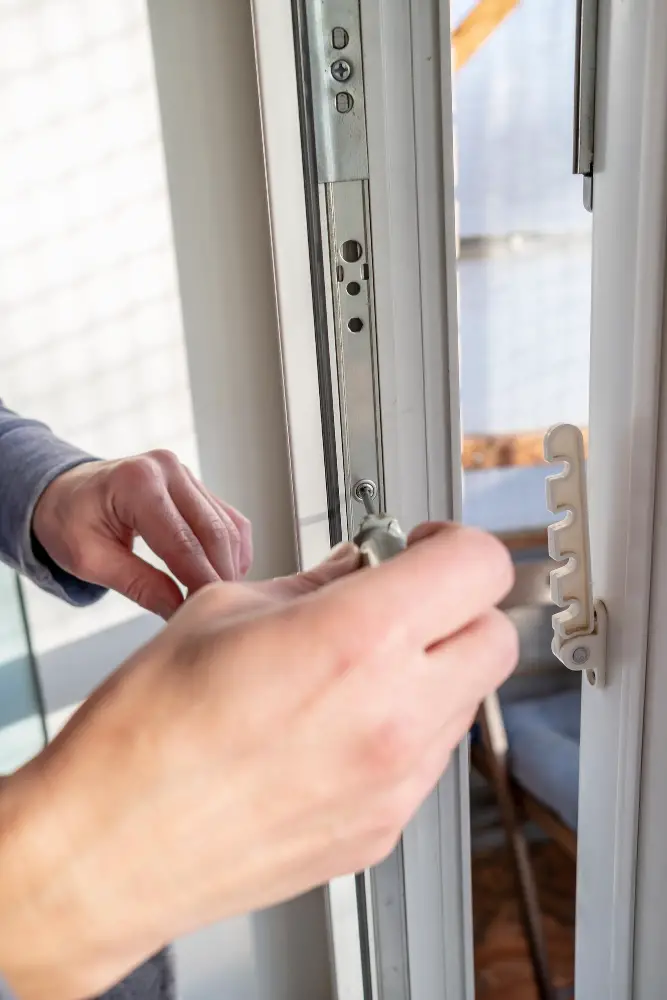
Before doing so, it’s important to take note of any hardware that needs removing. This includes doorknobs, locks and latches.
To remove a doorknob or lever handle, look for a small hole on the side of the knob or handle. Insert a paperclip into this hole and press down firmly until you feel resistance.
Then twist counterclockwise while pulling outwards on both sides of the knob/handle.
For deadbolts and other types of locks/latches with screws visible on one side only: use an appropriate screwdriver (usually Phillips head) to unscrew them from their respective plates before attempting removal altogether.
Removing Door Stops and Hinges (Optional)
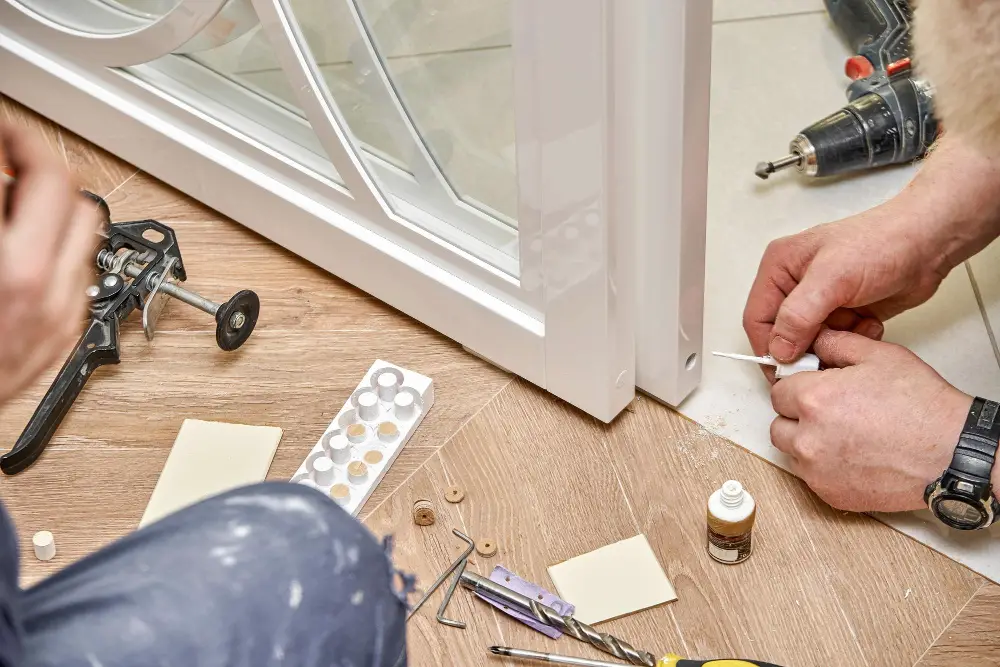
Door stops are small pieces of wood or metal that prevent doors from opening too far, while hinges connect the door to its frame. Removing these components will give you a few extra inches of clearance and make it easier to maneuver your furniture.
Before removing any hardware, make sure that it won’t damage the door or frame. If possible, use a screwdriver instead of pliers or other tools that could scratch surfaces.
To remove hinge pins:
- Open the door fully.
- Place an object (such as a nail) under one end of the hinge pin.
- Tap on this object with a hammer until it comes out slightly.
- Use pliers to pull out each pin completely.
To remove door stops:
- Locate where they are attached (usually at either side).
- Use screws driver for unscrewing them
- Remove them carefully
Navigating Stairs and Hallways

If your new home or apartment has narrow staircases or tight hallways, it’s important to measure these areas before attempting to move in your furniture. Take note of any turns or corners that may pose an obstacle for moving the couch through.
If you have multiple floors in your home, consider hiring professional movers who specialize in navigating stairs and tight spaces. They will have the necessary equipment and experience to safely move heavy items up and down flights of stairs without causing damage.
Alternatively, if you’re feeling confident about tackling this task yourself, make sure that there is enough clearance space on each step for both yourself and the couch. Use blankets or padding around sharp corners to prevent scratches on walls as well as protect the sofa from damage during transport.
Will My Sofa Fit Up the Stairs?

Staircases can present unique challenges when it comes to moving furniture, and it’s important to take some extra precautions before attempting to move your sofa upstairs.
Firstly, measure the width of your staircase and compare it with the dimensions of your couch. If there is not enough space for both items side by side, consider disassembling the sofa into smaller pieces that can be carried up separately.
Another option is using ropes or straps to hoist the couch over a balcony or through an open window on an upper floor. However, this method requires careful planning and should only be attempted by experienced movers.
It’s also essential to clear any obstacles from around stairways before attempting any heavy lifting. This includes removing pictures from walls along stairwells as well as ensuring that handrails are secure so they don’t come loose during transport.
Will My Sofa Fit in the Lift?

Even if your sofa fits through the front door of your unit, it may not fit inside the lift. Before moving day arrives, measure both the dimensions of your couch and that of the lift opening.
If you’re unsure about whether or not a particular piece of furniture will fit into a building’s elevator or up any stairs leading to its entrance, contact management for assistance. They can provide information on maximum weight limits and other restrictions that could affect delivery options.
In some cases where there is no way around getting large items upstairs without using an elevator (or even when there is), professional movers may be necessary due to safety concerns related to lifting heavy objects up flights of stairs manually.
Moving Techniques
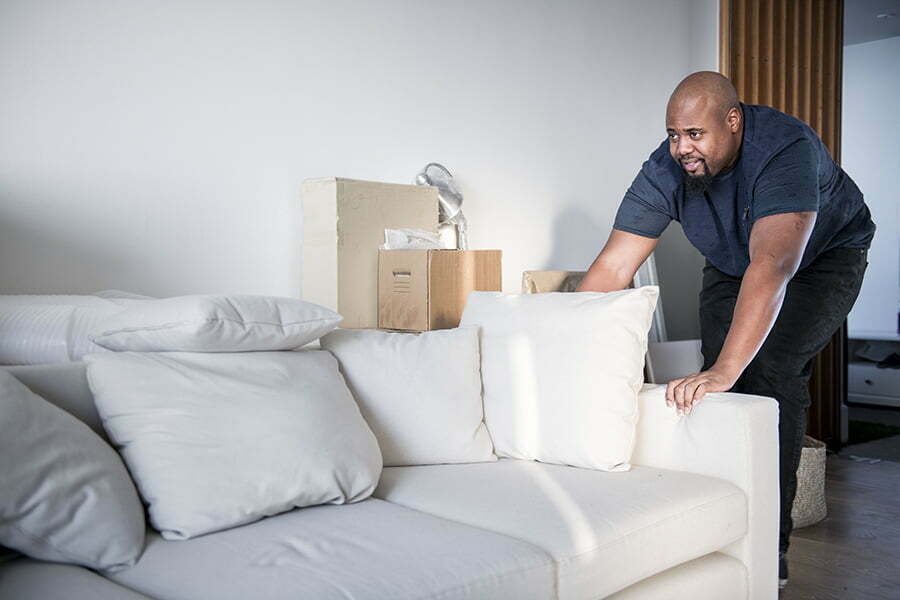
There are several techniques that can help make the process smoother and easier. One of the most common methods is to move the couch horizontally or vertically through doorways, hallways, and staircases.
If your sofa has removable legs or arms, take them off before attempting to move it through tight spaces. This will give you more room for maneuvering around corners and narrow openings.
Another technique is moving diagonally by tilting one end of the sofa up while keeping the other end on its wheels or feet. This method requires two people working together carefully as they navigate around obstacles like stairs.
In some cases where there are no alternative entry points available such as windows or balconies; consider hiring professional movers who have experience in handling large furniture items like sofas without causing any damage during transportation.
Moving the Couch Horizontally or Vertically
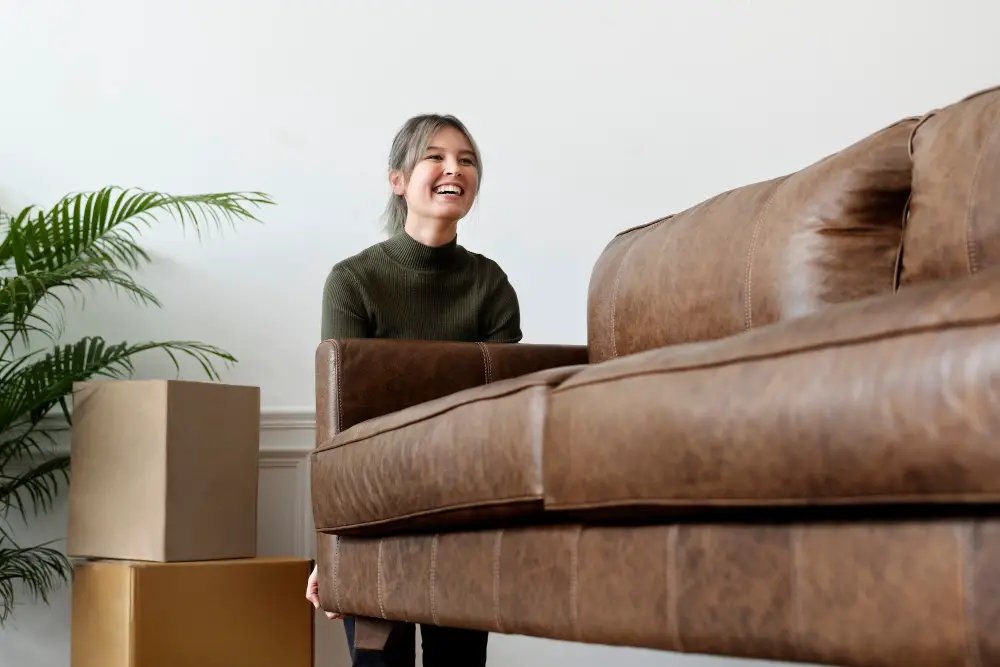
One option is to move the couch horizontally or vertically. This means tilting the furniture on its side or back and sliding it through the doorway.
Moving a couch horizontally requires two people: one person at each end of the sofa. Tilt one end of the sofa up while keeping it close to your body, then slide it slowly towards your partner who will be holding onto their end of the sofa as well.
Make sure you have enough space on either side so that you don’t damage any walls or other furniture.
Moving a couch vertically involves tipping it backward so that its bottom faces upward while standing in front of an open doorway with ample clearance above for lifting upwards without hitting anything overhead like light fixtures etc., then carefully lifting from underneath until both ends clear overhanging obstacles such as door frames before lowering again once inside where desired position has been reached.
Moving the Couch Diagonally

This technique involves tilting the couch at an angle and moving it through the door in a diagonal direction. It’s important to note that this method requires more than one person, as you’ll need someone on each end of the couch.
To move your sofa diagonally, start by lifting one end of the sofa while keeping it level with its other side. Then, pivot both ends towards each other so that they meet at an angle in front of your body.
Once you’ve done this successfully, slowly move forward until both ends are past any obstacles or tight spaces.
It’s essential not to force anything during this process as doing so can cause damage or injury.
Alternative Entry Points

This may include windows or balconies if you’re on a higher floor. However, this option can be risky and dangerous if not done correctly.
It’s important to hire professionals who have experience in moving furniture through unconventional entryways.
Another option is to use a crane or hoist system that can lift the couch over the balcony or roof of your building and into your home. This method requires careful planning as well as permits from local authorities.
Before considering these options, make sure that they are allowed by building regulations in your area and consult with professionals for advice on how best to proceed safely.
Delivery Options

Many furniture stores offer delivery services for an additional fee. This can be especially helpful if you have multiple pieces of furniture to move or if you don’t have access to a truck.
When scheduling your delivery, make sure that the company is aware of any potential obstacles such as narrow hallways or staircases. They may need to bring special equipment like dollies and straps in order to safely move your couch into its new home.
It’s also important to note that some companies may charge extra fees for difficult deliveries, so be sure to ask about this ahead of time. While it may cost more than moving the couch yourself, having professionals handle the job can save you time and stress in the long run.
Ultimately, whether you choose DIY methods or opt for professional help will depend on your personal preferences and circumstances.
Sofas for Narrow Doorways: Options and Suggestions

Fortunately, there are options available that will fit through even the smallest of openings. One option is to look for sofas with removable legs and arms.
This allows you to disassemble the sofa into smaller pieces that can be easily maneuvered through narrow doorways and hallways.
Another option is to consider purchasing a modular sectional sofa. These types of sofas come in individual pieces that can be arranged in different configurations depending on your space requirements.
They’re also easy to move since each piece is relatively lightweight.
If all else fails, consider hiring professional movers who specialize in moving large furniture items through tight spaces like narrow doorways and staircases.
Don’t let a small doorway or hallway prevent you from getting the perfect couch for your home! With these tips and tricks at hand – measuring dimensions accurately; assessing entry points; considering disassembly options; exploring alternative delivery methods – it’s possible to find a comfortable seating solution without compromising style or comfort!
FAQ
Can you get a couch through a door?
A couch can typically be moved through a door if its height or depth is 29 inches or less, as interior door openings are about 29 1/4 inches wide and exterior ones are 35 inches wide.
How do you fit a large sofa through a door?
To fit a large sofa through a door, remove the door by tapping out the hinge pins and shifting it sideways, and if necessary, remove the hinges for additional width.
Can a sofa fit through a 30 inch door?
A sofa with dimensions of 38″ depth and 34″ height can fit through a 30″ door, provided it has a straight path through the doorway.
What size couch can fit through a 29 inch door?
A couch that is no wider than 28 inches and no taller than 29 inches can typically fit through a 29 inch door.
What techniques can be used to maneuver a couch through a narrow doorway?
Techniques to maneuver a couch through a narrow doorway include removing cushions and legs, turning the couch at an angle, and using furniture sliders or a dolly for smoother movement.
Are there specific couch designs that are easier to move through tight doorways?
Yes, modular couch designs and those with removable parts are easier to move through tight doorways.
How can you determine if a couch will fit through your door before making a purchase?
To determine if a couch will fit through your door before making a purchase, compare the couch’s dimensions to the door’s dimensions to ensure it is smaller.




